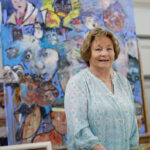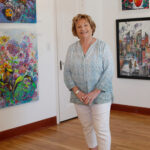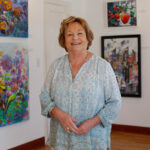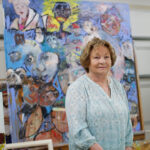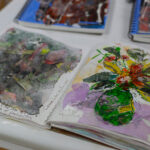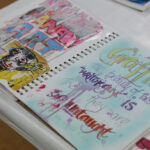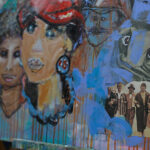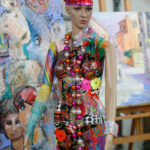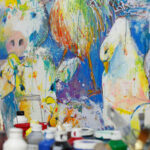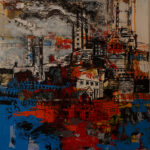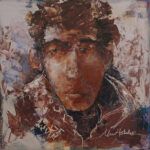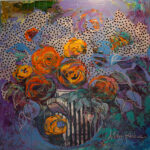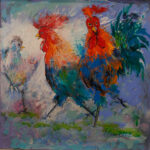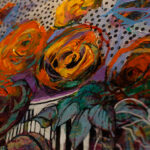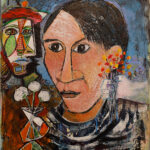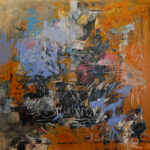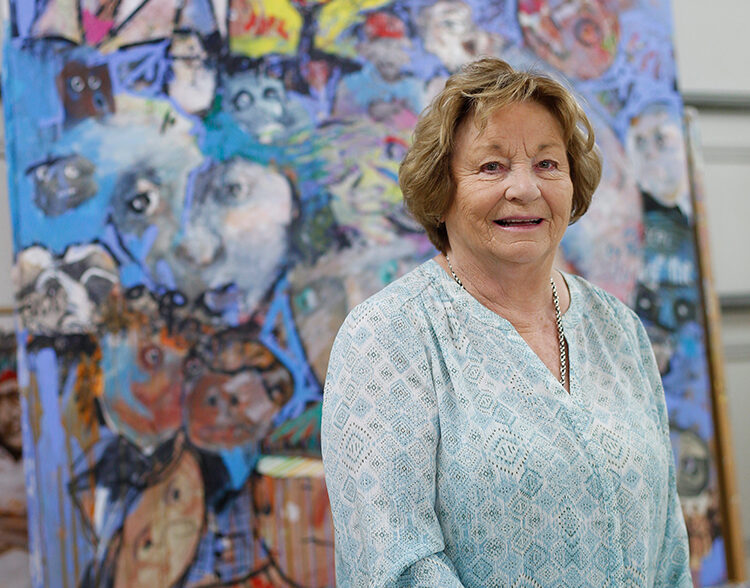
The exhibition “Mags Hobbs: Fun-light on Imagination,” on display at the Center for Spiritual Care through April 30, features the more recent works by Vero Beach artist Mags Hobbs.
Hobbs says she picked up a paintbrush again some 10 years ago, following a nearly 30-year hiatus spent raising her family, and for most of those 10 years she “followed the rules.”
More recently, however, she says she decided that “I will not follow any rules ever again.”
Having once “lived on the edge” with husband David Hobbs, a former champion race car driver and commentator, she today tries to take risks with her artwork as well. Tucked away in the corner of her studio are works that are technically perfect but don’t have what she calls “fun-life.”
The technique and skill levels of her earlier works remain in her current creations, but she has finally stopped self-criticizing her work, recognizing that she was “my own worst enemy.”
“I was conforming,” she admits, noting that the desire to color outside the lines had always been lurking in the background.
“Bit by bit, it’s been coming out more and more, and I just thought – I don’t have to follow any rules. The more I see of it, the more I don’t want to do it,” says Hobbs.
“I think I’m finally finding myself. You spend half your life toeing the line. I can appreciate technique and people’s ability, of course, but I don’t want to paint that way. The more I look at things, the more I began to realize, I really need to listen to what I like.”
Once she gave herself permission, she finally found her voice.
“I have more fun painting, and I love the freedom of it. I no longer agonize over a petal for three days. I want to forgive myself. I want to paint something crazy and feel OK about it,” says Hobbs, pondering whether that’s why she’s attracted to graffiti art.
“It’s so untaught, so untutored. They’ve [graffiti artists] never had a lesson in their lives. What comes out is so creative, even though it’s all over your walls. It’s raw, but it is amazing.”
Having studied art, drawing and painting, she says “now I’m into the deep construct/destruct side. I wish I’d never been taught a thing. I wish I had been left alone. It took me all this time to break away.”
Journaling, utilizing that same “no criticism” mantra, has become another freeing exercise.
“Anything that’s in my journals is just fun. You can always rip the page out if you really want to. I’ve been getting over myself, I suppose. I’ve been getting over all my training. I gave myself permission to be a graffiti artist if I want, like Basquiat,” says Hobbs, referencing the late Jean-Michel Basquiat, a highly influential contemporary artist.
“I just love the mark-making. If it’s not perfect, I’m delighted,” she adds.
Hobbs says that as she began moving away from realism to painting with emotion, she discovered what she calls “fun-light.”
She explains that she would sometimes look at one of her paintings and think, “It’s just dead, that painting; give it some life. That’s when I realized what I needed to do was put a bit of fun and some light into it.”
That “aha” moment led to experimentations with color, and using acrylics and collages to get a variety of textures. Her works generally begin with definition and she then breaks them down.
“In the initial drawing, I draw it with some care or planning. Then I try to get that fun-light into it. I don’t want it tight and orderly and precise. I don’t like that sort of thing myself, but I’ve not been brave enough to stray. Now I feel like I can draw anything because I don’t have to go too accurately,” Hobbs explains.
And, she says, because she is enjoying this new approach, the current works are more animated than those in the past.
“If you’re having fun doing it, that’s going to come through,” she says.
Referencing a piece she dubbed “Checking out the Chicks,” she explains the storyline for the scenario unfolding on canvas, where two roosters are vying for the attention of a rather lovely hen.
Having always been drawn toward animals, she has a veritable stable full of farm animals to show for it, including a spotted “Buttercup” acrylic on canvas and an 8-inch by 10-inch “American Bison” done in pen and ink wash that resembles the Lascaux cave drawings in France.
Another of her cow paintings, “Spots,” has no defined lines. “I love that sort of lost line thing,” she says, describing the imagery elicited with only hints of shape.
Hobbs says she creates with a freedom and looseness and lets each piece become what it is meant to be. The fluid lines often only hint at her vision, leaving it up to the viewer to independently finish the visual storytelling.
Her largest piece, “Painting of Faces,” has pride of place in her studio. Repurposed from an old canvas, she considers it a giant doodle pad. The faces began to appear after she had covered over the original painting, and she says they just kept coming.
“Once I saw one, I’d see another and another. I call it ‘The Face of the Human Race.’”
“It’s just something I do,” says Hobbs. “I realized what you need in a studio is something to paint on at all times. Maybe it’s the walls.”
Hobbs also loves playing with the vibrant colors and tricks that light and shade can play in flowers and still life, which she recently began drawing in pen.
“Poppies” and “Red Apples,” both 16-inch by 20-inch acrylic on canvas, showcase a looseness and vagueness that bring that “fun-light business” to fruition.
Hobbs says “Red Apples” was roughly done and as she was about to clean it up, thought, “’No!’ It’s essential to know when to stop. I’m getting better because I’m accepting them my way. You get brainwashed as a young person in school. For years you listen to everybody else who wants perfect little scenes.”
Hobbs says that early in the pandemic, she was moved by the poignancy of an image of people eating ice cream in the middle of the street in an empty New York City and, using acrylic and collage on canvas, produced “Taking Back Our City Streets,” a Florida version, with flowers growing willy-nilly in the streets.
“That’s what would happen in Florida. I like that it’s allegorical and of this time,” adds Hobbs.
Those pieces that do lean toward realism still have a sense of wild abandon through her use of color, mixed media and her own personality.
Hobbs has introduced some portraits to the mix, including one of a somber-looking lad whose soulfulness pulls you into the canvas. With another, she says that she couldn’t quite settle on who the person was.
“It took 10 days before I realized it was Picasso,” says Hobbs. “I thought, that’s a good idea. That’s what I’ll do. I’ll do an homage to Picasso.”
Hobbs generally has several paintings going at any time, which allows her to step away for a bit before overworking a piece.
“There was a time when everything would have to be perfect. Now, I go out of my way to make it absolutely unperfect. I asked myself why. That’s when it began to dawn on me. I’m doing it because that’s the accepted norm of what a painting should be or what a drawing should be. What I was doing was conforming, hugely, to the detriment to me,” shares Hobbs.
“Now, I’m painting for myself. I’ve made up my mind. I am painting for me.”
The Center for Spiritual Care is open by appointment only. Call 772-567-1233.
Photos by Kaila Jones

